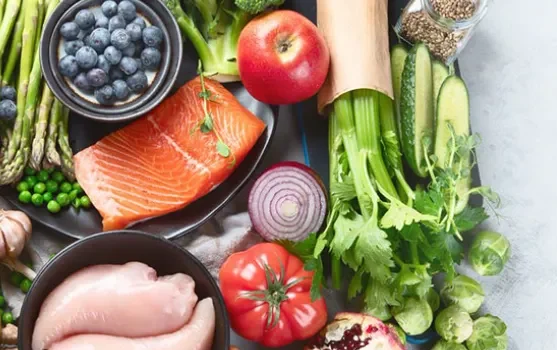
If you’re looking to manage your cholesterol levels and improve your overall heart health, incorporating fiber into your diet could be one of the most effective changes you can make. Fiber, particularly soluble fiber, has the ability to bind to cholesterol in your digestive system, helping to remove it from the body before it enters your bloodstream. By adjusting your eating habits to include more fiber-rich foods, you may be able to reduce your cholesterol levels naturally.
The Two Types of Fiber: Soluble vs. Insoluble
Dietary fiber comes in two forms: soluble and insoluble. Both are crucial for overall health, but soluble fiber is especially beneficial for reducing LDL (bad) cholesterol.
Soluble fiber dissolves in water to form a gel-like substance in your digestive system. This gel binds to cholesterol, helping your body eliminate it instead of absorbing it. Foods rich in soluble fiber include oats, beans, lentils, pears, apples, and psyllium husk.
On the other hand, insoluble fiber does not dissolve in water and plays a key role in promoting healthy digestion. It helps prevent constipation by adding bulk to stool. Foods high in insoluble fiber include vegetables, whole grains, seeds, and nuts. For optimal health, it’s important to include both types of fiber in your diet.
Start Your Day with Oats
One of the easiest ways to increase soluble fiber intake is by eating oatmeal for breakfast. Oats contain beta-glucan, a type of soluble fiber that is especially effective in lowering LDL cholesterol. Beta-glucan forms a thick gel that binds to cholesterol and helps your body expel it rather than absorb it.
To reap the benefits, try to have at least half a cup of cooked oatmeal, which provides around 4 grams of fiber. For an extra fiber boost, consider adding fresh fruits like bananas or berries to your oats. If you’re pressed for time, overnight oats soaked in milk can be an easy and nutritious breakfast option.
Incorporate Beans and Lentils
Beans and lentils are also excellent sources of soluble fiber. Varieties like black beans, kidney beans, garbanzo beans, navy beans, and lentils are all packed with fiber. Try swapping meat for beans or lentils in recipes like tacos, chili, burgers, and pasta dishes.
A single cup of cooked beans provides around 9 to 12 grams of fiber, making it easy to reach the recommended daily fiber intake of 25 grams. The fiber in beans helps prevent cholesterol from entering your bloodstream, while also providing antioxidants and other heart-healthy nutrients.
Snack on Fruits and Nuts
Fruits and nuts are another great way to add fiber to your diet without much effort. Most fruits contain pectin, a type of soluble fiber. Apples and pears are particularly fiber-rich, providing around 5 grams of fiber per medium-sized fruit. Berries, bananas, and oranges are also great sources of fiber.
Nuts, including almonds, also contribute insoluble fiber, which aids digestion. A small handful of nuts can provide around 2 to 3 grams of fiber. Additionally, the healthy fats found in nuts have been shown to improve cholesterol levels when consumed in moderation.
Add Ground Flaxseed to Your Meals
Flaxseed is another fantastic source of soluble fiber, along with heart-healthy omega-3 fatty acids. However, to get the full benefits, it’s important to grind flaxseeds before consuming them, as whole flaxseeds are not easily digested by the body.
Once ground, flaxseed can be added to oatmeal, smoothies, baked goods, and more. The fiber in flaxseed helps to remove cholesterol from the body by forming a gel during digestion. For maximum benefits, opt for ground flaxseed over flaxseed oil, as the oil does not contain fiber.
Use Avocados in Your Meals
Avocados are not only delicious but also rich in soluble fiber and healthy fats that can improve your cholesterol levels. Just half of a medium avocado provides about 5 grams of fiber, along with plenty of monounsaturated fats that support heart health.
Try mashing avocado for toast, adding it to salads, or blending it into smoothies. Replacing high-fat ingredients like cheese and meat with avocado can help further enhance the nutritional profile of your meals.
Eat More Vegetables
Increasing your intake of vegetables can significantly boost your fiber consumption. Aim for at least 5 to 9 servings of fruits and vegetables each day. Not only do these foods provide both soluble and insoluble fiber, but they are also low in fat and calories, making them heart-healthy choices.
Some of the best vegetable options for fiber include broccoli, Brussels sprouts, carrots, sweet potatoes, and green peas. When shopping for produce, make sure to fill your cart with a variety of colorful fruits and vegetables. Pre-washing and cutting your veggies can also make healthy snacking more convenient.
Consider Fiber Supplements
If you’re struggling to meet the recommended 25 grams of fiber per day through food alone, fiber supplements like psyllium husk can be a helpful addition to your diet. Psyllium is a soluble fiber that can help lower both total and LDL cholesterol levels by forming a gel in the stomach that traps bile acids.
While fiber supplements can be effective, they should not replace high-fiber foods, as whole foods provide essential nutrients, antioxidants, and other health benefits that supplements can’t offer. Before adding a fiber supplement to your routine, consult with your doctor to determine if it’s the right choice for you.
Incorporating more fiber into your diet is a simple yet powerful way to manage your cholesterol and support heart health. By making small, thoughtful changes to your eating habits, you can enjoy the benefits of lower cholesterol and a healthier lifestyle.












